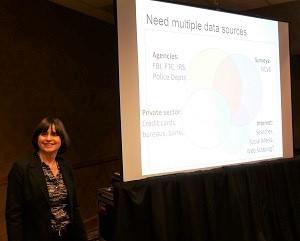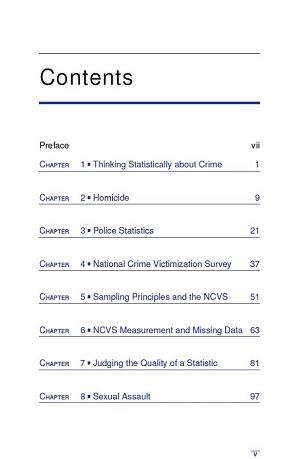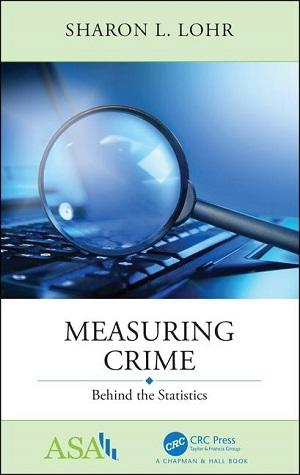Statistics Author of the Month - July: Sharon Lohr
CRC Press is pleased to share with you our author Q&A session with Sharon Lohr!

Measuring Crime : Behind the Statistics, 1st Edition
Author(s): Sharon L. Lohr
Price: $33.99
Cat. #: K349782
ISBN: 9781138489073
Publication Date: March 29, 2019
Binding: Paperback
Request e-Inspection Copy »
Q&A with Sharon Lohr
To what extent have you found yourself researching and writing your books as a result of being inquisitive on a personal level?
That’s entirely what drives my research and writing. Statistics is a wonderful profession for inquisitive people because you have the opportunity to learn about, and contribute to, almost any area of human knowledge. I’ve been privileged to work on projects studying appropriate uses and misuses of value-added models (employed in many states to evaluate schools and teachers), how many drivers and passengers wear seat belts, effects of feral pigs on Santa Cruz Island vegetation, individuals’ tobacco-use patterns over time, community views on aircraft noise, and of course measuring crime.
Whenever I read something, or see a statistic, my first question is “How do you know?” What’s the evidence? Where did the statistic come from, how were the data collected, and how accurate is the statistic likely to be for its intended use?
My book is intended for inquisitive readers who ask these questions about crime statistics they encounter. But more generally, the book discusses the statistical principles you can use to evaluate a statistic about any topic — crime, unemployment, prevalence of diabetes, public transportation usage, medical expenditures, literacy rates, sports, or anything else.
Is there one piece of research included in the book which surprised you or challenged your previous understanding of crime rate statistics?
Yes! The post-1970 papers I’d read about the history of crime statistics gave the impression that all the early work in the field was done by men. But when I looked at earlier writings I discovered that authors in the 1920s cited women’s contributions, among them a 1915 report titled “Statistics Relating to Crime in Chicago” by Edith Abbott, Ph.D.
Abbott evaluated the quality of the crime statistics available in 1915 — from the courts, police department, and correctional facilities — with insights that still resonate. Her report shows a remarkably modern view of interpreting and assessing statistics, at a time when newspapers sensationalized “crime waves” and some authors cherry-picked statistics or even made them up.
Abbott advocated combining and contrasting data sources to obtain a more comprehensive picture of crime and to identify ways to improve data collection systems — all themes of statistical research in 2019.
Amongst professionals in the statistical world, do you think there is a fear of analysing crime statistics?
No, I haven’t seen this. Statisticians tend to approach data analysis from the perspective of the data structure, not the subject matter. If your data are from a stratified random sample in which everyone selected for the sample has responded, then you can use the standard statistical methods that have been developed for stratified sampling, regardless of whether the data are about crime, astronomy, medicine, biology, accounting, agriculture, or something else. The beauty of statistical reasoning is that techniques that have been developed for a particular data set in one field will work for any other data set with the same structure.
That said, I think there are a lot of research opportunities in the area of crime statistics. The information collected by police departments is a form of “big data,” and it shares many characteristics of other types of big data. Some crimes don’t appear in the data set or may be incorrectly classified, and some of the properties of statistics estimated from those data are unknown. The FBI is transitioning to a system that collects more details about individual crime incidents, and a lot of research is needed on how to deal with missing data in that system and assure data quality. At the same time, surveys asking US residents about their experiences with crime have lower response rates than in the past, and more research is needed on how to mitigate the effects of nonresponse and how to get accurate answers from the survey participants.
A big challenge today is the same one that Edith Abbott identified in 1915: how to take the data from all the disparate sources of information about crime and weave them into a comprehensive picture.
Did you have to develop any analysis techniques in order to interpret crime information?
I have done that over the years, but for Measuring Crime: Behind the Statistics I looked at how standard principles of statistical reasoning apply to information about crime. I examined how I and other statisticians critique a statistic, and distilled these procedures into a checklist of eight questions that can be applied to any statistic you encounter.
I think that newspaper reporting about crime statistics has improved, but you still see statistics quoted in some articles without a source and without any mention of how trustworthy they are. My checklist can help journalists and interested readers evaluate the statistics for themselves.
For example, you often see a headline such as “Homicide doubled in City X” after the FBI’s annual crime statistics are released. The headline gives the impression that lawlessness is taking over and it’s not safe to leave your house, when in reality City X had one homicide in 2017 and two homicides in 2018. Or you might read that the average amount stolen from senior citizens who are victimized by paid caregivers is $18,540 — but the article does not mention that the statistic is based on three cases of financial elder abuse from one state’s social service agency records, and there is no basis for believing the statistic applies to other senior citizens.
What inspired you to get into analysing statistics?
A lot of things. But I think a big part of it is that I loved math and wanted to be able to use math to make a difference. I also wanted to be able to continue learning about lots of areas and not spend my entire career confined to some narrow specialty. Much of my research has focused on how to design surveys and experiments so that they will provide the information needed to advance science or set policy. I love being able to come up with a design that will not only provide answers to a scientist’s research questions, but give even more information than she had thought possible with her budget.
Gertrude Cox, one of my statistical heroes, captured the sense of joy from working in statistics when she wrote: “In searching the unknown for new truths, there is mystery, and there is adventure, and there is the thrill of discovery.”






